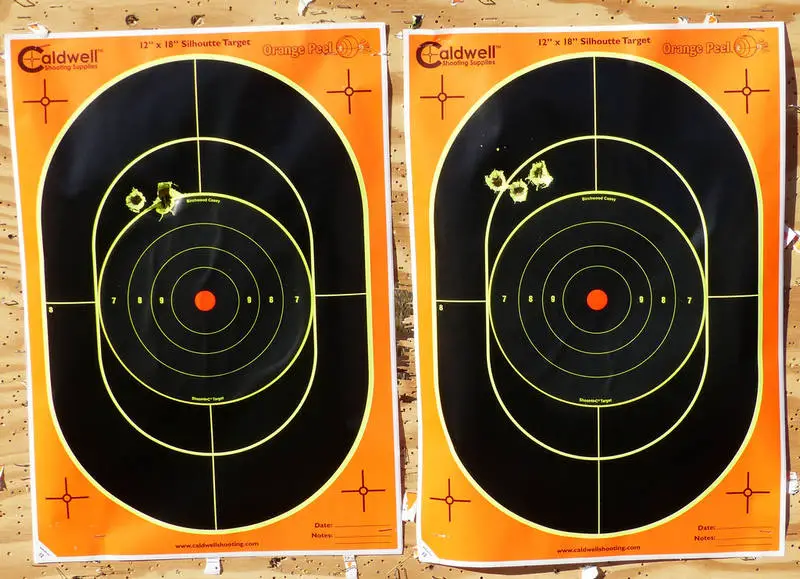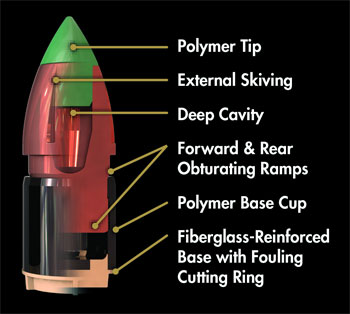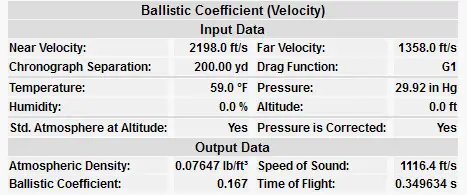


Federal's Breakthrough Muzzleloading Bullet : Trophy Copper 270 grain B.O.R. Lock MZ

The left group at 101 yards was shot with 80 grains by weight of Blackhorn 209 (114 grains by volume) and the right target was shot immediately after with 91 grains by weight of Blackhorn 209 (130 grains by volume), out of a Remington Model 700 Ultimate Muzzleloader.
Federal has finally released the most innovative muzzleloading projectile in decades, and . . . it works. For years, rightly or wrongly, muzzleloading hunters have been grousing a bit about spit-patching their barrels so they can get their next load down the chute, carped about sabots that load too tight, and as a result the horribly poor-performing “Powerbelt” has become popular.
Flyweight pistol bullets act like varmint bullets when they touch bone at high velocities, another problem as standard muzzleloading velocities have grown faster. As a rule of thumb, it you want accuracy, projectiles need to load tightly if you want tight groups. Conicals should engrave and so should sabots. An undersized bullet that rattles down your barrel is prone to rattling and yawing on the way out: it isn't likely to remain concentric with the bore.
It is a further problem in a few backward states that don't allow sabots like Colorado, apparently not comprehending that the patch in “patch and ball” is a sabot and does the same thing, taking up windage in the bore. And, some states (California) have inflicted senseless “no-tox” lead bullet bans in an effort to further harass hunters and firearm owners. So, it can be quite a mess.

The new Federal 270 grain Trophy Copper has no discarding sabot, for the sealing mechanism is integral with the bullet. Upon firing, the base of the bullet assembly is driven forward, over the bullet itself, expanding the black polymer ring that takes up windage in the bore and seals at the same time. It is a sabotless design, a .50 caliber “bore-sized” bullet and it loads with just a couple of fingers on the ramrod, practically falling down the bore. The base of the bullet keeps the bullet right where you seated it.
As the bullet itself is heat-treated copper alloy, it promises essentially 100% weight retention and is approved for use where lead bullets are not. Though the packaging says to use it in a 1:28 rate of twist barrel “for best results,” that makes little sense. I tested it in a Remington Model 700 Ultimate Muzzleloader with a 1:26 rate of twist and will be trying it in several rifles in the future, including 1:24 rate of twist Savages.

Though Federal has not provided a ballistic coefficient yet, Federal does claim 2198 fps muzzle velocity with 120 grains by volume of Blackhorn 209 from a 24 inch test barrel. Based on the 1358 fps retained velocity at 200 yards published by Federal with this load, the 200 yard B.C. is .167.
Federal also publishes 1794 fps with two T7 pellets, with a 200 yard velocity of 1125. That also equates to a .167 200 yard G1 B.C.
Though being .50 caliber with fairly light for caliber weight prevents it from having a high ballistic coefficient, it is slightly better than a .452 diameter 250 grain Hornady XTP. If you remove the base and polymer ring from this bullet assembly, you have essentially a 250 grain bullet itself. Note the 275 grain Trophy Copper slug used in Federal's 20 gauge saboted round has a published G1 B.C. of .171. As a shooting B.C. varies quite a bit in concert with ambient conditions, using a static B.C. of .167 should be close enough to use for starting purposes.
Federal has done a fabulous job here, for no one in their right mind would bother fighting with a Powerbelt ever again. Now, if you're using Blackhorn 209 with this new Federal, you'll never lick a patch again, you can leave all your cotton patches, swabbing solvents, Bore Butter, short starters, and other assorted oddities of inconvenience at home . . . and just go hunting.
Copyright 2014 by Randy Wakeman. All Rights Reserved.

Custom Search


